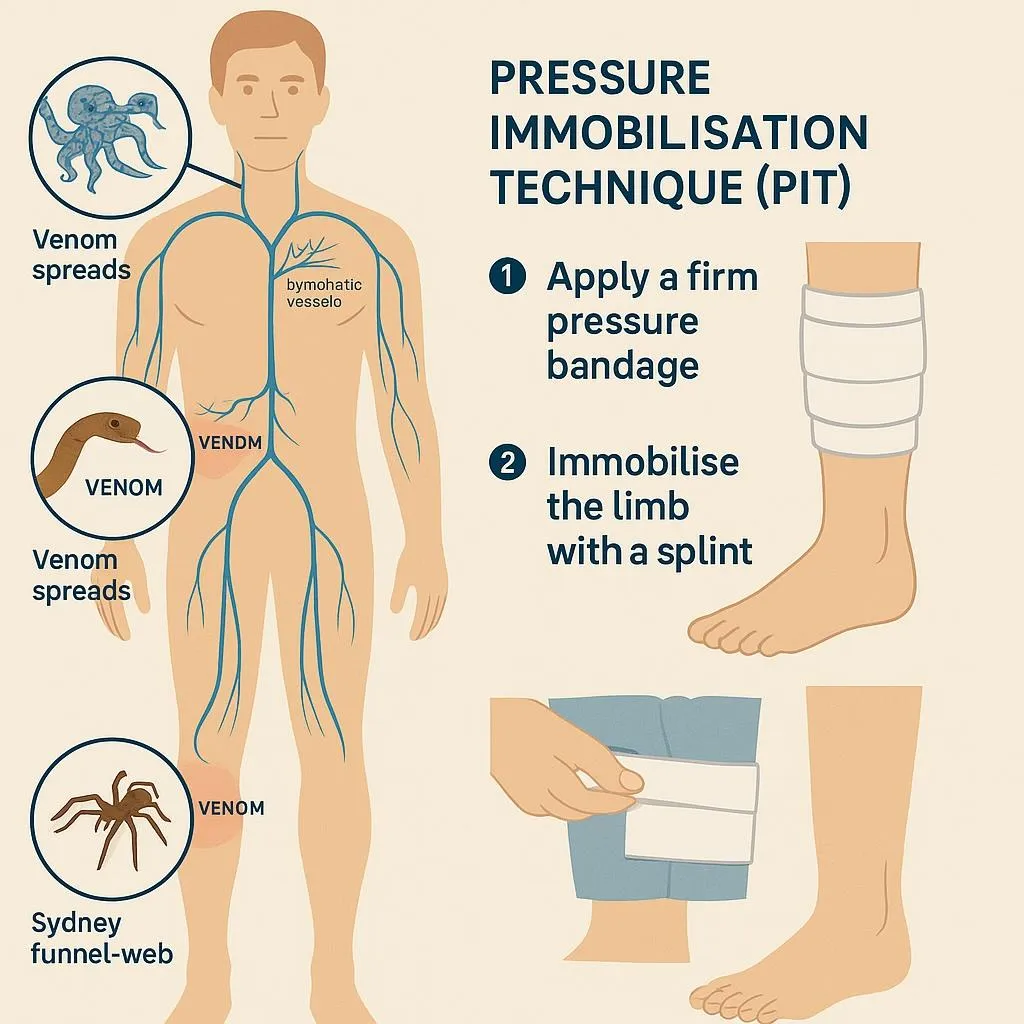
Venom, the Lymphatic System, and the Pressure Immobilisation Technique
Venomous bites and stings are unforgiving. The Pressure Immobilisation Technique (PIT) can slow venom spread and save lives while waiting for medical help.
This article explains when and how to apply PIT correctly for snakes, spiders, and marine creatures found across Australia. You’ll learn the science behind lymphatic flow, common mistakes to avoid, and how proper first aid training gives you the control to stay calm in chaos. Knowledge turns fear into action.
From king brown snakes to funnel-web spiders, Australia’s wildlife demands respect and readiness. This REACHAU resource hub explores venom types, body responses, and first aid priorities for high-risk environments. Learn how to recognise symptoms, apply correct treatment, and avoid outdated myths that still circulate online. Whether you work outdoors or live regionally, these guides keep you informed and prepared for the unexpected.Venom, the Lymphatic System, and the Pressure Immobilisation Technique
Australia is home to some of the most venomous creatures on earth including the blue-ringed octopus, venomous snakes, and the Sydney funnel-web spider. What they all have in common is how their venom spreads inside the human body and how first aid can slow it down.
How Venom Travels in the Body
Unlike infections or poisons that spread through the bloodstream, most dangerous venoms in Australia move primarily through the lymphatic system.
The lymphatic system is a network of vessels that run parallel to your veins. Instead of pumping blood, these vessels carry lymph, a clear fluid that helps fight infection and drain waste. But unlike the circulatory system, the lymphatic system doesn’t have a heart to pump it. It relies on muscle movement to keep fluid flowing.
That means if someone is bitten and they move around, they’re actually helping the venom spread more quickly through their body.
Blue-Ringed Octopus
The blue-ringed octopus injects tetrodotoxin, a neurotoxin that paralyzes muscles including those needed for breathing. The venom moves via the lymphatic system to the bloodstream, where it can rapidly affect the nervous system.
Snake Bites
Most Australian venomous snakes inject venom that affects the nervous system (neurotoxic),blood clotting (haemotoxic), or muscle tissue (myotoxic). Regardless of type, the venom enters the lymphatic system first. That’s why a snake bite victim may not collapse immediately but can deteriorate suddenly if the venom spreads unchecked.
Funnel-Web Spider
The Sydney funnel-web spider’s venom contains a neurotoxin called atracotoxin, which interferes with nerve signalling. Like with snakes and the blue-ringed octopus, the venom uses the lymphatic system as its highway into the bloodstream.
The Pressure Immobilisation Technique (PIT)
This is where first aid comes in. The Pressure Immobilisation Technique (PIT) is designed to do two things:
Apply firm pressure over the bite site and the affected limb to compress lymphatic vessels.
Immobilise the limb with a splint or bandage to prevent muscle movement that would normally pump lymph fluid around.
By slowing down the lymphatic flow, you give the casualty vital time. It doesn’t neutralise the venom, but it delays its spread until emergency medical care is available.
Why It Works
Think of the lymphatic system like a sponge. If you squeeze or move it, fluid travels quickly. But if you hold it tightly and keep it still, fluid barely moves at all. That’s exactly what PIT does for venom.
The Key Takeaway
For snake, funnel-web spider, and blue-ringed octopus bites:
Call 000 immediately.
Keep the casualty calm and as still as possible.
Apply a pressure immobilisation bandage and splint.
Do not remove the bandage until medical help takes over.
Doing something is always better than doing nothing. PIT saves lives because it buys time.
✅ Want to be confident applying lifesaving skills like this?
At REACHAU, our First Aid training goes beyond “what to do” we teach you why it works, so when your brain checks out under pressure, your training kicks in.
👉 Visit reachau.com.au to book your First Aid training today.
